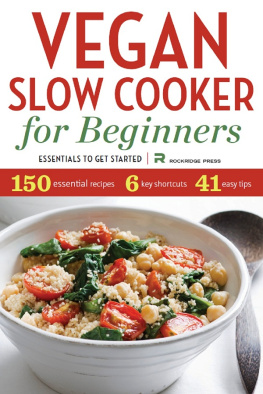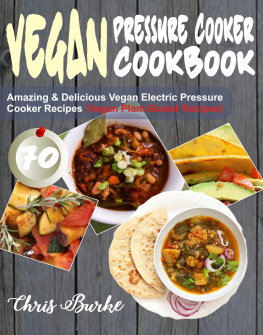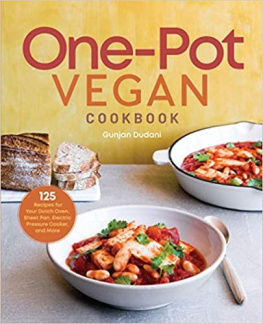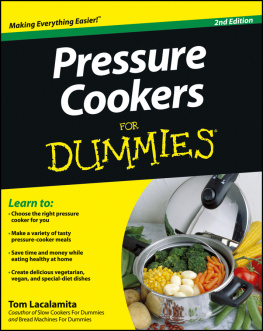
Copyright 2016 by Jill Nussinow, MS, RDN
Photography 2016 by Lauren Volo
Illustrations by Olivia de Salve Villedieu
Book design by Alissa Faden
All rights reserved.
PLEASE MAKE SURE WHEN USING A PRESSURE COOKER TO FOLLOW THE MANUFACTURERS INSTRUCTIONS FOR SAFE USE. THE PUBLISHER AND THE AUTHOR DISCLAIM RESPONSIBILITY FOR ANY ADVERSE EFFECTS RESULTING DIRECTLY OR INDIRECTLY FROM INFORMATION CONTAINED IN THIS BOOK, INCLUDING BUT NOT LIMITED TO THOSE RESULTING FROM THE USE OF A PRESSURE COOKER.
For information about permission to reproduce selections from this book, write to or to Permissions, Houghton Mifflin Harcourt Publishing Company, 3 Park Avenue, 19th Floor, New York, New York 10016.
www.hmhco.com
Names: Nussinow, Jill, author.
Title: Vegan under pressure : perfect vegan meals made quick and easy in your pressure cooker / by Jill Nussinow.
Description: Boston : Houghton Mifflin Harcourt, 2016.
Identifiers: LCCN 2015038039| ISBN 9780544464025 (paperback) | ISBN
9780544464032 (ebook)
Subjects: LCSH: Vegan cooking. | Pressure cooking. | Quick and easy cooking.
| BISAC: COOKING / Vegetarian & Vegan. | COOKING / Methods / Special
Appliances. | COOKING / Methods / Quick & Easy. | LCGFT: Cookbooks.
Classification: LCC TX837 .N8846 2016 | DDC 641.5/636--dc23
LC record available at http://lccn.loc.gov/2015038039
Some base recipes and reference information have been previously published in slightly different form in The New Fast Food by Jill Nussinow.
v1.0116

Contents
INTRODUCTION
Ive always cared about my food, what I ate, what it tasted like, and also how healthy it was for me. Thats why I became a Registered Dietitian. Food is an integral part of my personal and professional life. I have also followed a vegetarian diet, and then a vegan diet, since I was a teenager. When I first took meat off the menu and moved to a plant-based diet, Id spend hours cooking whole grains and dried beans. I didnt have enough time in my busy life to invest in cooking the way that I wanted to eat. Almost twenty years ago I rediscovered the age-old method of pressure cooking. It had been there right under my nose all the timein my mothers kitchen.
My mother used a pressure cooker for standbys like pot roast, coq au vin, and lentils. As a kid, I feared the hissing pot with the scary jiggler on top. I avoided the kitchen when it was in use. Moms cooker actually blew its top once, resulting in food everywhere, including the ceiling. I swore off the idea of using a pressure cooker until my growing love of beans and grains cooked from scratch coincided with the advent of the safer, modern, spring-valve cookers in the early 1990s, providing the impetus for me to join the pressure cooking crowd.
At the time few were extolling the devices virtues. But Lorna Sass, the queen of pressure cooking and my mentor, had just written her book Cooking Under Pressure in 1989 and begun her one-woman crusade. When I saw Lorna in action, I realized that I needed to hop on the bandwagon and learn everything I could about the art of pressure cooking.
When I got my hands on a modern, sleek, and shiny stainless steel pressure cooker in 1995, I started experimenting and quickly was able to produce amazing resultsdishes full of intense flavor in a matter of minutes. Shortly thereafter, I began teaching classes to educate others about the virtues of pressure cooking. Becoming a vegan pressure cooking expert has taken time and experimentation to refine my techniques and build my recipe repertoire.
Using a pressure cooker has changed my cooking life and my health. Time and energy spent in the kitchen has decreased while my energy level and diet of fabulous healthy food has improved. Gone are the excuses for not eating better-tasting whole foods. I can cook flavorful beans, vegetables, soups, stews, fillings, sauces, and so much more in an hour or lessand now you can too.
Pressure cooking is not foolproof, and its not difficult: Using a pressure cooker is a skill that you can learn with expert guidance and attentiveness. It differs from traditional stovetop cooking or what I learned in nutrition school. In spite of the old wives tales and even the story of my moms pressure cooking mayhem, the modern pressure cooker is extremely safe when the instructions are followed.
First and foremost: pay attentionto the food you are cooking, the size and type of your cooker, the heat source, altitude, and amount of liquid (both in the food itself and additional liquid). Just like when you learned to drive a car, ride a bicycle, or any other new skill, practice and focus leads to success.
Start with the basics: Get to know your cooker. Read the manufacturers instructions carefully. The biggest variable will be the food. One batch of dried beans may be very different from the next. The new potatoes picked yesterday cook faster than regular supermarket potatoes. The reason? Moisture content in freshly picked fruits and vegetables is higher than the moisture in produce that has been sitting on the shelves, or traveling, for days.
Take notes as you use these recipes, and adjust time and liquid for your pressure cooker, ingredients, preferences, and environment. Remember that the best part of cooking with the pressure cooker is that even if the result is overcooked food, you can almost always use it. Well-cooked beans, grains, and vegetables can easily become dips, spreads, soups, or burgers.
Do you live at higher altitudes? You probably know that it takes longer to cook. The pressure cooker will make seemingly impossible-to-cook dishes, such as dried beans, possible. You can even use your pressure cooker to boil water more quickly.
Many people are so excited to get their pressure cooker and cant wait to start cooking. But the first recipe that I suggest you try is the water test (see ), which will not result in anything to eat or drink, as the water is at almost 250Ftoo hot to even make a good cup of tea. However, you will learn how your cooker works and what to expect from it when it reaches pressure.
While I generally encourage creative cooking, when you are learning to use a pressure cooker, its not the time for experimentation. Wait until you have some practice, hone your pressure cooking technique, and then let your creative juices flow.
6 Pressure Cooking Rules
Follow these rules carefully to prevent potential problems and you will quickly love the results you achieve with your cooker:
Read the manufacturers instructions that come with your pressure cooker.
Always add the amount of liquid to the pressure cooker that the recipe specifies.
Never attempt to fry in the cooker.
Dont overfill the cooker: half full for beans or grains or foods that expand, two-thirds full for all else.
Dont leave the house while using a stovetop pressure cooker.
Read through this book and experiment with these and your own recipes for the best results.
Most people limit their vegan pressure cooking to artichokes or legumes. They are missing the full extent of what the pressure cooker can do. Grains cook in half the time of stovetop cooking. Cooking lovely legumes takes minutes, not hours, from either dried or soaked beans. Green vegetables cook quickly, in just a minute or two, and have enhanced flavor; winter vegetables such as squash, beets, celery root, and potato pieces are tender in just a few minutes; and fruit turns into tasty compotes in just a couple of minutes. Your pressure cooker will serve you well from breakfast through dessert. My goal is to teach and share with you my experience and love of pressure cooking. I use my pressure cooker daily. It has become the most important appliance that I own and I hope it will become yours too.
Next page










